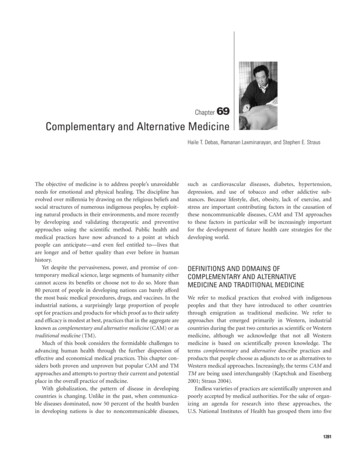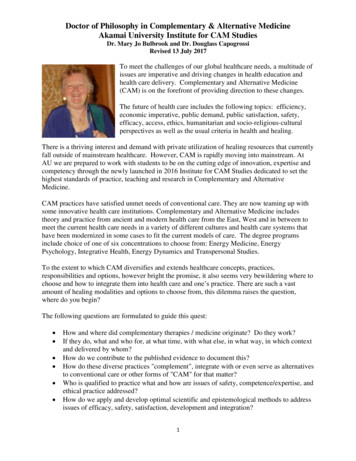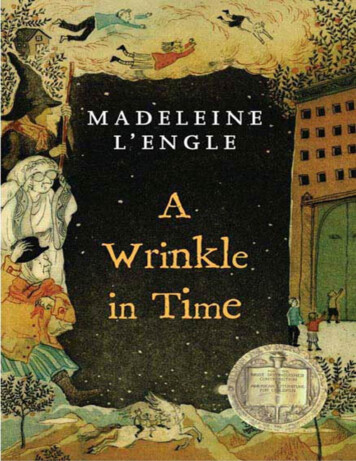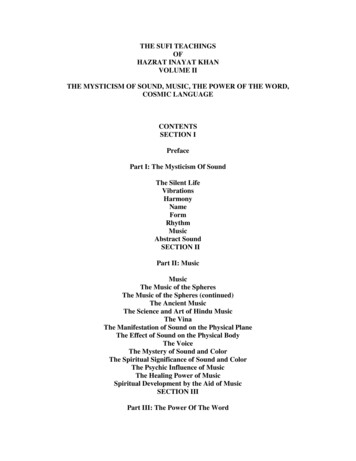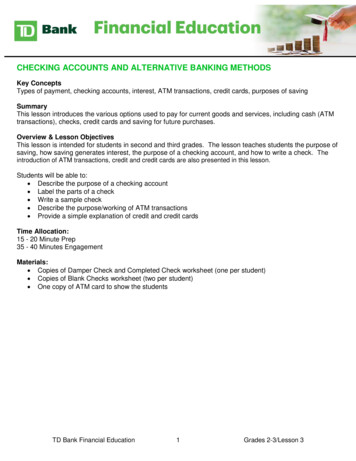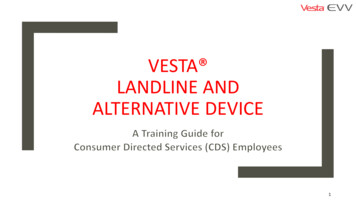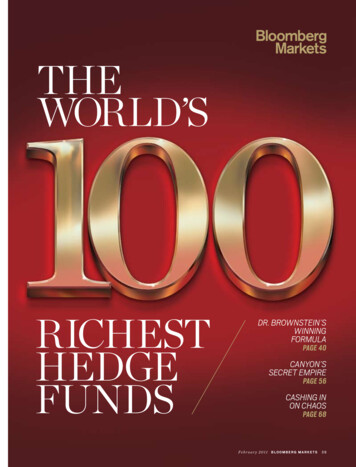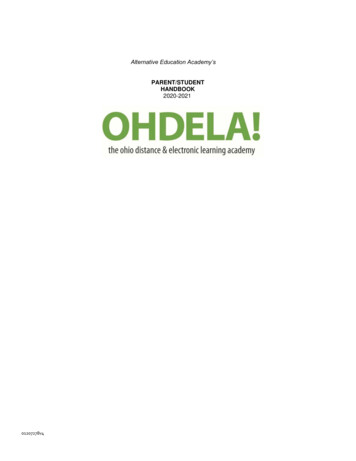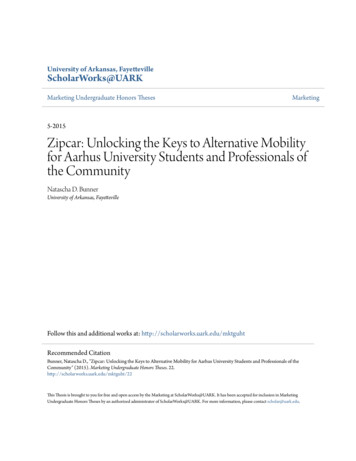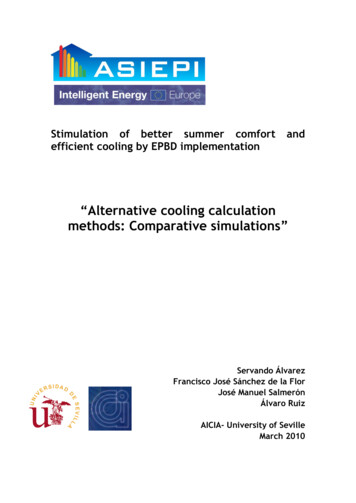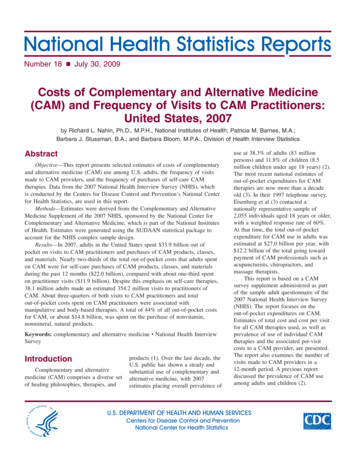
Transcription
Number 18 n July 30, 2009Costs of Complementary and Alternative Medicine(CAM) and Frequency of Visits to CAM Practitioners:United States, 2007by Richard L. Nahin, Ph.D., M.P.H., National Institutes of Health; Patricia M. Barnes, M.A.;Barbara J. Stussman, B.A.; and Barbara Bloom, M.P.A., Division of Health Interview StatisticsAbstractObjective—This report presents selected estimates of costs of complementaryand alternative medicine (CAM) use among U.S. adults, the frequency of visitsmade to CAM providers, and the frequency of purchases of self-care CAMtherapies. Data from the 2007 National Health Interview Survey (NHIS), whichis conducted by the Centers for Disease Control and Prevention’s National Centerfor Health Statistics, are used in this report.Methods—Estimates were derived from the Complementary and AlternativeMedicine Supplement of the 2007 NHIS, sponsored by the National Center forComplementary and Alternative Medicine, which is part of the National Institutesof Health. Estimates were generated using the SUDAAN statistical package toaccount for the NHIS complex sample design.Results—In 2007, adults in the United States spent 33.9 billion out ofpocket on visits to CAM practitioners and purchases of CAM products, classes,and materials. Nearly two-thirds of the total out-of-pocket costs that adults spenton CAM were for self-care purchases of CAM products, classes, and materialsduring the past 12 months ( 22.0 billion), compared with about one-third spenton practitioner visits ( 11.9 billion). Despite this emphasis on self-care therapies,38.1 million adults made an estimated 354.2 million visits to practitioners ofCAM. About three-quarters of both visits to CAM practitioners and totalout-of-pocket costs spent on CAM practitioners were associated withmanipulative and body-based therapies. A total of 44% of all out-of-pocket costsfor CAM, or about 14.8 billion, was spent on the purchase of nonvitamin,nonmineral, natural products.Keywords: complementary and alternative medicine c National Health InterviewSurveyIntroductionComplementary and alternativemedicine (CAM) comprises a diverse setof healing philosophies, therapies, andproducts (1). Over the last decade, theU.S. public has shown a steady andsubstantial use of complementary andalternative medicine, with 2007estimates placing overall prevalence ofuse at 38.3% of adults (83 millionpersons) and 11.8% of children (8.5million children under age 18 years) (2).The most recent national estimates ofout-of-pocket expenditures for CAMtherapies are now more than a decadeold (3). In their 1997 telephone survey,Eisenberg et al (3) contacted anationally representative sample of2,055 individuals aged 18 years or older,with a weighted response rate of 60%.At that time, the total out-of-pocketexpenditure for CAM use in adults wasestimated at 27.0 billion per year, with 12.2 billion of the total going towardpayment of CAM professionals such asacupuncturists, chiropractors, andmassage therapists.This report is based on a CAMsurvey supplement administered as partof the sample adult questionnaire of the2007 National Health Interview Survey(NHIS). The report focuses on theout-of-pocket expenditures on CAM.Estimates of total cost and cost per visitfor all CAM therapies used, as well asprevalence of use of individual CAMtherapies and the associated per-visitcosts to a CAM provider, are presented.The report also examines the number ofvisits made to CAM providers in a12-month period. A previous reportdiscussed the prevalence of CAM useamong adults and children (2).U.S. DEPARTMENT OF HEALTH AND HUMAN SERVICESCenters for Disease Control and PreventionNational Center for Health Statistics
Page 2MethodsData sourceThe statistics shown in this reportare based on data from the AdultComplementary and AlternativeMedicine supplement of the 2007 NHIS(4). NHIS, which is in the fieldcontinuously, is conducted by theCenters for Disease Control andPrevention’s National Center for HealthStatistics. It is a survey of a nationallyrepresentative sample of the civilian,noninstitutionalized householdpopulation of the United States. In thefamily section, basic health anddemographic information is collected onall household members. All adultmembers of the household who arehome at the time of the interview areinvited to participate and respond forthemselves, with proxy responsesallowed for persons unavailable at thetime of the interview. Additionalinformation is collected on onerandomly selected adult aged 18 yearsor over (sample adult) and onerandomly selected child aged 0–17 years(sample child) in each family.Information on the sample adult isself-reported except in rare cases whenthe sample adult is physically ormentally incapable of responding, andinformation on the sample child iscollected from an adult who isknowledgeable about the child’s health,usually a parent.The 2007 CAM supplement wasadministered to sample adults andrespondents for sample children. Itincluded questions on 36 types of CAMtherapies used in the United States,including 10 types of provider-basedCAM therapies (e.g., acupuncture,chiropractic and osteopathicmanipulation, traditional healers) and 26other CAM therapies for which theservices of a provider are not necessary(e.g., nonvitamin, nonmineral, naturalproducts; special diets; movementtherapies); see ‘‘Technical Notes,’’‘‘Definition of terms,’’ for a list anddescriptions of all 36 CAM therapies.Following the taxonomy ofunconventional health care proposed byKaptchuk and Eisenberg (1), stressNational Health Statistics Reports n Number 18 n July 30, 2009management classes, support groups,and religious (faith) healing are notincluded in the definition of CAM usedin this report, although questions ontheir use were included in the CAMsupplement. Within the CAMsupplement, one section asked aboutparticipants’ use of ‘‘herbalsupplements.’’ This section queriedparticipants on a list of 45 dietarysupplements that went beyond thecategory of ‘‘herbal supplements’’ toinclude such items as androstenedione,carnitine, creatine, DHEA, fish oils,glucosamine, lutein, lycopene,melatonin, omega fatty acids, prebioticsor probiotics, and SAM-e, but notvitamins or minerals. Therefore, to morecorrectly label this extensive set ofdietary supplements in this report, thisgroup of supplements is referred to asnonvitamin, nonmineral, naturalproducts.Inclusion and development of the2007 CAM supplement was supportedby seven institutes, centers, or offices ofthe National Institutes of Health: National Center for Complementaryand Alternative Medicine National Heart, Lung and BloodInstitute National Institute of Allergy andInfectious Disease National Institute of Child Health andHuman Development National Institute of Mental Health Office of Behavioral and SocialScience Research Office of Dietary SupplementsStrengths and limitations ofthe dataA major strength of the NHIS CAMdata is that they were collected for anationally representative sample of U.S.adults, allowing estimation of CAM usefor a wide variety of populationsubgroups. The large sample size alsofacilitates investigation of theassociation between CAM and a widerange of other self-reported healthcharacteristics included in the NHIS,such as health behaviors, chronic healthconditions, injury and poisoningepisodes, access to medical care, andhealth insurance coverage.The NHIS questions have severallimitations: 1) The questions aredependent on respondents’ memory andtheir willingness to report useaccurately. 2) The collection of surveydata at a single point in time results inan inability to produce consecutiveannual prevalence estimates, and canreduce the ability to produce reliableprevalence estimates for smallpopulation subgroups, as this couldrequire a larger sample and more thanone year of data. 3) The total costs perperson for nonvitamin, nonmineral,natural products and homeopathy werecalculated by multiplying the amountspent at the most recent purchase by thenumber of purchases per year. Becausedata were not available for the exactcost at each purchase, and the mostrecent purchase may not have beentypical of the respondent’s usualpurchase of CAM products, theestimates may contain errors.Statistical analysisIn 2007, NHIS interviews werecompleted in 29,266 households, whichyielded 75,764 persons in 29,915families and a household response rateof 87.1%. This report is based on datafrom 23,393 completed interviews withsample adults aged 18 years and over.The final 2007 sample adult responserate was 67.8%. Procedures used incalculating response rates are detailed inAppendix I of the Survey DescriptionDocument, NHIS data files (5).All estimates and associatedstandard errors shown in this reportwere generated using SUDAAN, asoftware package designed to accountfor a complex sample design such asthat of NHIS (6). All estimates foradults were weighted, using the sampleadult record weight, to represent theU.S. civilian, noninstitutionalizedpopulation aged 18 years and over.Estimates were calculated usingrecodes for the number of times therespondent saw various CAMpractitioners, the amount paid out ofpocket for each CAM practitioner visit,
National Health Statistics Reports n Number 18 n July 30, 2009the number of times self-care therapieswere purchased, and the amount paidout of pocket for the self-care therapy(see ‘‘Technical Notes,’’ ‘‘Calculation ofestimates,’’ for a detailed explanation ofthe recodes and ‘‘Definition of terms’’for definitions of CAM practitioner andself-care therapies). Persons withunknown CAM information have beenexcluded from the analysis.In tables shown in this report,estimates with a relative standard errorof more than 30% but less than or equalto 50% are identified with an asterisk(*), indicating that they are statisticallyunstable due to small sample size.Estimates with a relative standard errorof greater than 50% are indicated with adagger (†) and are not shown.ResultsOut-of-pocket costs for CAM(figure) In 2007, adults in the United Statesspent 33.9 billion out of pocket onvisits to CAM practitioners andpurchases of CAM products, classes,and materials (see figure). Nearly two-thirds of the totalout-of-pocket costs that adults spenton CAM were for self-care purchasesof CAM products, classes, andmaterials during the past 12 months( 22.0 billion) compared with aboutone-third spent on practitioner visits( 11.9 billion) (see figure). A total of 44% of all out-of-pocketcosts for CAM was spent on thepurchase of nonvitamin, nonmineral,natural products (see figure).CAM practitioner therapies(Tables 1–3) In 2007, 38.1 million adults made anestimated 354.2 million visits toCAM practitioners, at an estimatedout-of-pocket cost of 11.9 billiondollars (Table 1). About three-quarters of both visits toCAM practitioners and total out-of pocket costs spent on CAMpractitioners during the past 12months were associated withPage 3Total costs: 33.9 billion1NVNMNP 14.8 billion (43.7%)Self-care costs 22.0 billion(64.8%)Yoga, tai chi, qigong classes 4.1 billion (12.0%)Homeopathic medicine 2.9 billion (8.7%)Practitioner costs 11.9 billion(35.2%)Relaxation techniques 0.2 billion (0.6%)1Nonvitamin, nonmineral, natural products.NOTES: Percentage refer to the total out-of-pocket costs in 2007. Totaling individual self-care cost percentages is affected byrounding. Estimates are based on household interviews of a sample of the civilian, noninstitutionalized population.DATA SOURCE: CDC/NCHS, National Health Interview Survey, 2007.Figure. Out-of-pocket costs for complementary and alternative medicine among adultsaged 18 years and over: United States, 2007manipulative and body-basedtherapies (Table 1). On average, adults in the UnitedStates spent 121.92 per person forvisits to CAM providers and paid 29.37 out of pocket per visit. Someof the highest per-person, out-of pocket costs are associated with visitsto practitioners of naturopathy andchelation therapy, while one of thelowest per-person, out-of-pocket costsis associated with visits topractitioners of chiropractic orosteopathic manipulation therapy(Table 2). For most types of CAM therapies, themajority of adults spent less than 50per visit to a practitioner. However, atleast 20% of persons visitingpractitioners of acupuncture,homeopathy, naturopathy, massage,and hypnosis therapy paid 75 ormore per visit (Table 3).CAM self-care therapies(Tables 4–5) Nonvitamin, nonmineral, naturalproducts ( 14.8 billion) accounted forthe majority of out-of-pocket dollarsspent on CAM self-care purchases(Table 4). Adults who made CAM self-carepurchases spent a total of 4.1 billionout of pocket on yoga, tai chi, orqigong classes (Table 4). Adults spent 2.9 billion out ofpocket on the purchase ofhomeopathic medicine in 2007(Table 4). Across categories of self-care CAMproducts, most adults who purchasedthe products spent less than 30 perpurchase. However, about 5% ofindividuals who bought nonvitamin,nonmineral, natural products or whopurchased self-help materials to learnrelaxation techniques spent more than 120 per purchase (Table 5).DiscussionUsing data from the 2007 NHIS, weestimate that U.S. adults spent about 33.9 billion out of pocket on visits toCAM practitioners and on purchases ofCAM products, classes, and materials.This equates to 1.5% of total health-careexpenditures in the United States and to11.2% of out-of-pocket health-careexpenditures (7). Almost two-thirds ofCAM costs were associated withself-care therapies such as nonvitamin,nonmineral, natural products;homeopathic products; and yoga. Ofthis, the public spent 14.8 billion outof pocket to purchase nonvitamin,nonmineral, natural products—about31% of the amount that the public spentout of pocket to buy pharmaceuticaldrugs in 2007 ( 47.6 billion) (7). Thepublic also spent 12.4 billion out ofpocket on visits to CAM providers, or
Page 425% of that spent out of pocket forconventional physician services ( 49.6billion) (7).It has been 10 years since the la
CAM. About three-quarters of both visits to CAM practitioners and total out-of-pocket costs spent on CAM practitioners were associated with manipulative and body-based therapies. A total of 44% of all out-of-pocket costs for CAM, or about 14.8 billion, was spent on the purchase of nonvitamin, nonmineral, natural products. Keywords:

